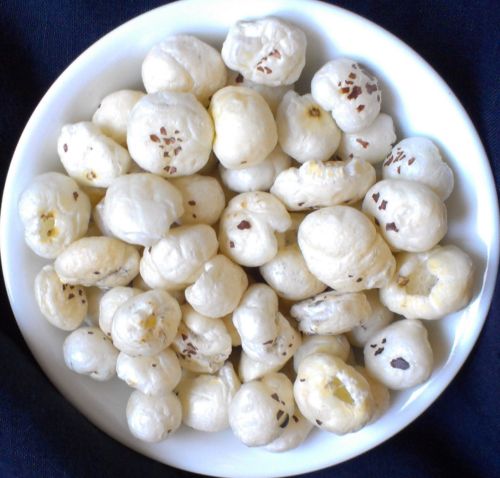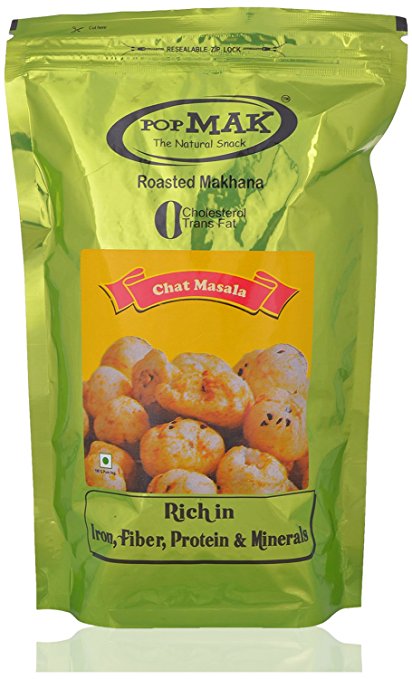Why is Makhana a wonder snack food ?
By Madhurie Singh, March 26, 2017

Makhana is also known as gorgon nuts, fox nut is actually the seed of a water plant called prickly water lily or gorgon which is not Lotus. It is the only food among all the food for fasting, that is not just high in carbohydrates but also in protein. It can be cooked in salty and sweet dishes for both snack and meals.
I am in love with makhana as its the quickest and easiest snack I can cook for my sons which is healthy too. Watch this video to appreciate how painfully difficult it is to make makhana!
I started eating more Makhanas as my tribute to this community whose living is dependent on Makhanas. 🙂
The farmers in Bihar collect this from the ponds by hands and process the seeds at home bearing great heat of the fire every day!
We are lucky to be able to eat this wonder food in all the parts of India and abroad thanks to many enterprising entrepreneurs.
Makhana is one of the lightest yet nutritious super food that can be served as snacks, sweet or savory dishes. I like to snack on them and so do my sons. They make me buy 10 packets every month.
Why do I allow my children to snack on Makhanas so much?
Makhanas, when sauteed in desi ghee with salt has been my favorite snack but not very frequent until I researched about its nutritional values.
| Food Item | Source Type | Nutritional Value (100gm) | |||
| Carbohydrate | Protein | Fat | Minerals | ||
| Makhana/ Foxnut | Seed of Gorgon | 77g | 9.7g | 0.1g | Vit C, Vit B3, B6, Mn, Iron, Ph, K, Mg, Ca, Omega 3 |
As a mother what do you look for in a food? Protein, Carbohydrate, Omega 3, healthy Fat, as many Vitamins and Minerals. Right?
Makhana has a very high quantity of Protein. Let me help you with the amount of protein found in common food we eat.
Let’s learn how much protein children need.
- Calculate your protein intake as 2 – 2.2g/kg body weight.
- if your child’s weight is body weight is 10 Kg, then he needs 20 gm protein per day.
- if your child’s weight is body weight is 15 Kg, then he needs 30 gm protein per day.
- if your child’s weight is body weight is 20 Kg, then he needs 40 gm protein per day.
- if your child’s weight is body weight is 25 Kg, then he needs 50 gm protein per day.
- if your child’s weight is body weight is 30 Kg, then he needs 60 gm protein per day.
- if your child’s weight is body weight is 35 Kg, then he needs 70 gm protein per day.
- if your child’s weight is body weight is 40 Kg, then he needs 80 gm protein per day.
- if your child’s weight is body weight is 45 Kg, then he needs 90 gm protein per day.
- if your child’s weight is body weight is 50 Kg, then he needs 100 gm protein per day.
- if your child’s weight is body weight is 55 Kg, then he needs 110 gm protein per day.
- if your child’s weight is body weight is 60 Kg, then he needs 120 gm protein per day.
- Let me take a body weight of 30 Kg of a child who needs 60 gm protein.
- Divide the total protein quantity of 60 gm into 6 meals or 4 meals or 3 meals based on how many times you serve food. If 6 meals then you need 60gm/6 meals = 10 g protein per meal. But if its 4 meals, then you need to give 60gm/4 meals = 7.5 g protein per meal. Four meal is the least one should be serving to a child. As an adult, you may stick to whatever you plan.
If a lunch is 1 roti (1 g protein) + 1/2 cup dal (4 g protein) + 1/2 cup curd (10 g protein) + veggies (1 g protein) + rice (2 g protein), then you are getting only 18 g protein! The question is does your child eat all these in one meal? Mine don’t. So I roughly ensure every meal has more than 6 g protein.
Morning Breakfast Milk 6 g
Short Break has Biscuits, Khakhras, Fruits = 10 g protein
Long Break has Stuffed paratha / Bread with Cheese Slice/ Roti with Chicken nuggets = 10 – 20 g
Lunch has 1 cup Rice (2 g protein) + 1 cup dal (15 g protein) + Veggies (1 gm protein) + salad = 18-23g
Milk in the evening 6 g
Dinner has 2 Rotis ( 2 g protein) + Chicken/ Paneer / Eggs/ Fish/ Chole = 15 – 25 g protein
There days when I do not have anything healthy cooked, then I give them Makhanas as snacks either in the snack box or in the evening with milk. Now a days when exams are going on and kids are home by 12 noon, they are constantly snacking. Keeping readymade Makhana packets has really helped me. I buy different flavors of Popmak Makhana and keep it visibly stacked in the kitchen. This has reduced their dependency on unhealthy potato chips a lot.
https://madhuriesingh.com/fat-fit/health-product-reviews/why-during-fasting-seeds-and-roots-are-consumed/
Makhana is a very versatile item that can be eaten as savory or sweet dish.
We are high Adrenal functioning people and always snacking on high protein but salty items. But my mom makes yummy Makhana kheer by chopping makhanas into tiny bits and cooking in thick milk. It is an extremely tasty nutritional sweet dish. You must try it.
A unique snack that I have been making is Makhana Bhel for my sons. I mix chopped onions, tomatoes, coriander leaves, lemon juice, puffed rice and spicy ready to eat makhanas from Popmak. I have to tell you it not only is filling but absolutely not loaded with too much carbohydrate that gets converted into glucose easily.
Another way to eat Makhana is with daal chawal. My sons like to eat something tangy and crunchy with daal chawal. So Makhana also comes handy.
I am going to challenge you, moms, to come up with new recipes with Makhana especially if you are trying to lose weight. Then we can have a competition of the best recipe. I will probably ask the Makhana company PopMak to sponsor the winner! What say, people? Do you accept the challenge?
This article is sponsored by PopMak.
| Protein Source | gm |
| 1 egg | 6gm |
| 1 egg white | 3gm |
| 100g Chicken | 26gm |
| 100g Fish | 18gm |
| 100gms Paneer | 20gm |
| 100gms Curd | 5gm |
| 100ml Milk | 5gm |
| 1 cup cooked Dal | 7gm |
| 1 cup cooked Sprouts | 7gm |

[…] Read: Why is Makhana a wonder snack food? […]
Login is required
Don't have an account? Sign Up